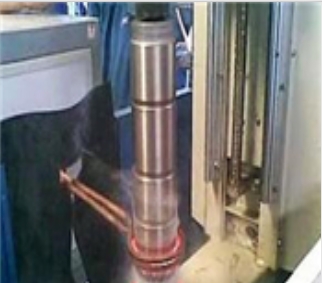- 14
- Sep
Spline shaft quenching equipment

Spline shaft quenching equipment
1. Product features
1. Induction heating does not need to heat the workpiece as a whole, and can selectively heat a part of the workpiece, so as to achieve the goal of low power consumption, and the deformation of the workpiece is not obvious.
2. The heating speed is fast, which can make the workpiece reach the required temperature in a very short time, even within 1 second. As a result, the surface oxidation and decarburization of the workpiece are relatively slight, and most of the workpieces do not need gas protection.
3. The surface hardened layer can be adjusted and controlled by adjusting the working frequency and power of the equipment as needed. As a result, the martensite structure of the hardened layer is finer, and the hardness, strength and toughness are relatively high.
4. The workpiece after heat treatment by induction heating has a thicker toughness area under the surface hard layer, which has better compressive internal stress, which makes the workpiece more resistant to fatigue and breaking.
5. The heating equipment is easy to install on the production line, easy to realize mechanization and automation, easy to manage, and can effectively reduce transportation, save manpower, and improve production efficiency.
6. One machine can be used for multiple purposes. It can complete heat treatment processes such as quenching, annealing, tempering, normalizing, and quenching and tempering, as well as welding, smelting, thermal assembly, thermal disassembly, and heat-through forming.
7. Easy to use, simple to operate, and can be started or stopped at any time. And there is no need to preheat.
8. It can be operated manually, semi-automatically or fully automatically; it can work continuously for a long time, or it can be used at random when it is used. It is conducive to the use of the equipment during the low electricity price discount period.
9. High utilization rate of electric energy, environmental protection and energy saving, safety and reliability, and good working conditions for workers are advocated by the state.
2. Product use
Quenching
1. Quenching of various gears, sprockets, and shafts;
2. Quenching of various half shafts, leaf springs, shift forks, valves, rocker arms, ball pins and other automobile and motorcycle accessories.
3. Quenching of various internal combustion engine parts and deceleration surface parts;
4. Quenching treatment of machine tool bed rails in the machine tool industry (lathes, milling machines, planers, punching machines, etc.).
5. Quenching of various hand tools such as pliers, knives, scissors, axes, hammers, etc.
Diathermic forging
1. Hot heading of various standard parts, fasteners, various high-strength bolts and nuts;
2. Diathermic forging of bars with a diameter of less than 800mm;
3. Hot heading and hot rolling of mechanical parts, hardware tools, and straight shank twist drills.
Welding
1. Welding of various diamond composite drill bits;
2. Welding of various hard alloy blades and saw blades;
3. Welding of various picks, drill bits, drill pipes, coal drill bits, air drill bits and other mining accessories;
Annealing
1. Various super audio frequency induction heating equipment or local annealing treatment
2. Annealing treatment of various stainless steel products
3. Heating annealing and swelling of metal materials
Other
1. Heating coating of aluminum-plastic pipes, cables and wires;
2. Aluminum foil seals used in the food, beverage, and pharmaceutical industries
3. Welding of gold and silver jewelry
4. Precious metal smelting: smelting gold, silver, copper, etc.
This product is suitable for the heating and quenching heat treatment process of various auto parts, motorcycles, engineering machinery, wind power, machinery factories, tool factories and other parts.
